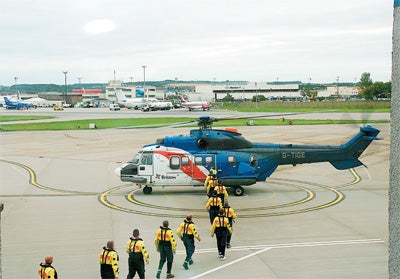Offshore helicopter pilot
The offshore helicopter sector is an oasis of success in difficult times for the aviation industry

Your support helps us to tell the story
From reproductive rights to climate change to Big Tech, The Independent is on the ground when the story is developing. Whether it's investigating the financials of Elon Musk's pro-Trump PAC or producing our latest documentary, 'The A Word', which shines a light on the American women fighting for reproductive rights, we know how important it is to parse out the facts from the messaging.
At such a critical moment in US history, we need reporters on the ground. Your donation allows us to keep sending journalists to speak to both sides of the story.
The Independent is trusted by Americans across the entire political spectrum. And unlike many other quality news outlets, we choose not to lock Americans out of our reporting and analysis with paywalls. We believe quality journalism should be available to everyone, paid for by those who can afford it.
Your support makes all the difference.While the rest of the aviation industry is reeling from high fuel prices and struggling to survive, one sector is in a period of growth: the offshore helicopter sector. These aircraft provide the vital service for the global multi-billion pound oil industry as it exploits oil fields and explores new fields for world consumption. Indeed, the trend now sees rich oil fields being exploited further and further away from the coast, which means a need for larger and more powerful helicopters to service these rigs.
Offshore helicopters transfer highly paid oil rig workers, engineers and executives to oil rigs and mobile survey vessels all over the world in the quest for "black gold". In addition, pilots of these aircraft will often have to fly in all weathers to evacuate rig workers in emergencies or for compassionate leave. The flying, therefore, is some of the toughest outside of military flying, with pilots having to set down on tiny landing platforms in the middle of the night, with few visual cues to help them. In addition, some oil rigs float, which means their landing pads will heave and move. Pilots also have to land on the ships that support giant oil drilling expeditions.
The Bristow Group is one of the largest and most recognisable names in the industry. Based in Aberdeen, it has operations all around the world servicing the North Sea rigs, including the Gulf of Mexico, Australia and even developing offshore markets such as Ghana and Nigeria. Its fleet operates a variety of helicopters, such as Eurocopter EC225s, Eurocopter Super Pumas, Eurocopter Tigers and Sikorsky S-92s, as well as smaller, single-engine types such as Bell 206s for the Gulf of Mexico fields. The company also has options on two of the new Bell/Agusta BA609 Tiltrotors, which could be very useful in the future for reaching new oil fields that are further away from civilisation.
Passenger service
The scale of these operations has to be seen to be believed. Aberdeen Airport, for example, is one of the busiest non-military helicopter bases in the world. It's a hub for Bristow's North Sea operations as well as hosting offshore helicopter providers Bond and CHC, which service the oil industry. Bristow runs around 50 flights a day, including BAe 146s, which take oil workers to Bristow's Orkney base, where the passengers board Sikorsky S-92s to reach the far northern rigs. Time is money in the oil industry, and these helicopters must meet commercial airline-style availability and punctuality targets to avoid contract penalties from clients.
In fact, the passenger experience for oil workers travelling to rigs is not unlike taking a commercial fight: there is a check-in desk, security screening facility, lounge and other familiar airport procedures. However, the donning of a rubber immersion suit and the mandatory seven-minute safety briefing video is a jolting reminder of the hostile conditions in which these helicopters operate. Safety is of paramount importance when survival without the appropriate protection in the wintry North Sea can be measured in minutes. As such, the procedures and equipment are all of the highest quality.
Pilot training
This level of sophistication also extends to the crews that operate in this demanding environment. Previously, the offshore industry used to employ a high number of ex-military pilots, many of whom would have already had the necessary all-weather rotary skills. However, today the majority have a civil background, with younger - and, increasingly, female - pilots entering the business. One Bristow captain, for example, is 24 and has previously flown coastguard missions. All pilots need a commercial airline pilot's licence as well as a helicopter licence, and the majority of pilots have taken the self-sponsored route. Instrument training is also vital for pilots working as part of all-weather missions.
For those who are thinking of becoming a commercial pilot but are worried about the current airline situation, it may be worth considering the offshore helicopter industry. The flying is challenging and well paid, while the locations you could end up working in are spread around the globe. As the world's energy demands increase, the need to exploit oil resources that lie further and further away from the coast - such as in the Arctic - will become ever more vital. Hand in hand with that, the helicopter operations that support these missions will be even more important.
Tim Robinson is deputy editor of 'Aerospace International', an RAeS publication
Join our commenting forum
Join thought-provoking conversations, follow other Independent readers and see their replies
0Comments